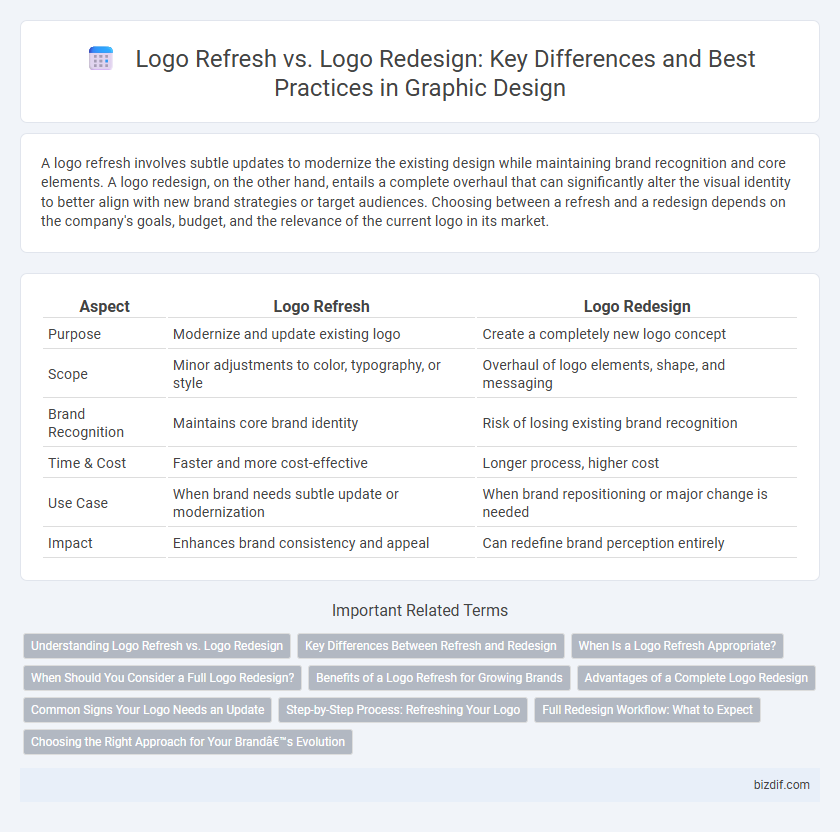A logo refresh involves subtle updates to modernize the existing design while maintaining brand recognition and core elements. A logo redesign, on the other hand, entails a complete overhaul that can significantly alter the visual identity to better align with new brand strategies or target audiences. Choosing between a refresh and a redesign depends on the company's goals, budget, and the relevance of the current logo in its market.
Table of Comparison
| Aspect | Logo Refresh | Logo Redesign |
|---|---|---|
| Purpose | Modernize and update existing logo | Create a completely new logo concept |
| Scope | Minor adjustments to color, typography, or style | Overhaul of logo elements, shape, and messaging |
| Brand Recognition | Maintains core brand identity | Risk of losing existing brand recognition |
| Time & Cost | Faster and more cost-effective | Longer process, higher cost |
| Use Case | When brand needs subtle update or modernization | When brand repositioning or major change is needed |
| Impact | Enhances brand consistency and appeal | Can redefine brand perception entirely |
Understanding Logo Refresh vs. Logo Redesign
Logo refresh involves subtle updates to existing design elements to enhance brand relevance without altering core identity, preserving brand recognition. Logo redesign entails a comprehensive overhaul of visual components, often reflecting a strategic shift or repositioning in the market. Understanding the distinction helps businesses decide between maintaining legacy elements and pursuing a bold transformation for future growth.
Key Differences Between Refresh and Redesign
Logo refresh involves subtle updates to a brand's existing logo elements, such as color tweaks, font adjustments, or minor shape changes, aimed at modernizing the design without losing brand recognition. Logo redesign represents a comprehensive transformation of the visual identity, often introducing completely new concepts, color schemes, and typography to redefine the brand's image. The key differences lie in the scope and impact: refresh maintains brand continuity with minimal disruption, while redesign focuses on significant evolution or repositioning of the brand.
When Is a Logo Refresh Appropriate?
A logo refresh is appropriate when brand recognition is already strong but the visual elements look outdated or lack relevance in the current market. It involves subtle updates to colors, typography, or minor graphic tweaks that enhance modernity while preserving the core identity. This approach helps maintain brand consistency and consumer trust without the risks associated with a complete logo redesign.
When Should You Consider a Full Logo Redesign?
A full logo redesign is essential when a brand undergoes significant shifts in its mission, target audience, or market positioning that a mere refresh cannot address. Consider a complete overhaul if the existing logo feels outdated, fails to resonate with current consumer trends, or lacks scalability for digital platforms. Opting for a full redesign helps establish a strong and relevant brand identity that supports long-term business goals and growth.
Benefits of a Logo Refresh for Growing Brands
A logo refresh preserves brand recognition while modernizing visual appeal, helping growing brands stay relevant without alienating existing customers. This approach enhances brand consistency across evolving platforms by updating colors, fonts, and minor graphics rather than overhauling the entire design. Refreshing a logo improves market perception, supports seamless brand evolution, and boosts customer loyalty through subtle yet impactful visual updates.
Advantages of a Complete Logo Redesign
A complete logo redesign offers businesses the advantage of fully revitalizing their brand identity, making it more relevant to current market trends and consumer preferences. It allows for the integration of modern design elements, improved scalability across digital platforms, and stronger visual appeal that can differentiate a brand from competitors. Unlike a logo refresh, a redesign can strategically address fundamental issues such as outdated symbolism or color schemes, resulting in enhanced brand recognition and long-term customer engagement.
Common Signs Your Logo Needs an Update
Common signs your logo needs an update include outdated design elements, poor scalability in digital formats, and inconsistent brand representation across platforms. A logo refresh typically involves subtle changes to color, typography, or minor tweaks to enhance modern appeal without losing brand recognition. In contrast, a logo redesign introduces a completely new visual identity, addressing fundamental shifts in brand strategy or market positioning.
Step-by-Step Process: Refreshing Your Logo
Refreshing your logo involves a step-by-step process starting with analyzing current brand elements and identifying outdated aspects to modernize. Next, subtle adjustments like tweaking color palettes, refining typography, and simplifying shapes enhance brand consistency without losing recognition. Conducting stakeholder feedback sessions and iterative revisions ensures the refreshed logo maintains relevance while aligning with evolving market trends.
Full Redesign Workflow: What to Expect
A full logo redesign workflow typically involves comprehensive market research, brand analysis, and multiple concept iterations to ensure alignment with current brand values and target audience preferences. Designers prioritize creating a distinct visual identity by redefining typography, color schemes, and iconography while maintaining relevance and scalability across platforms. Expect collaborative feedback loops with stakeholders and rigorous testing to finalize a dynamic, versatile logo that resonates in competitive graphic design landscapes.
Choosing the Right Approach for Your Brand’s Evolution
A logo refresh modernizes existing elements to maintain brand recognition while enhancing visual appeal, making it ideal for brands seeking subtle updates aligned with current trends. A logo redesign involves a complete overhaul, best suited for brands undergoing significant strategic shifts or rebranding efforts to redefine their market presence. Evaluating factors like brand heritage, target audience, and marketing goals ensures the choice between refresh and redesign supports effective brand evolution.
Logo Refresh vs Logo Redesign Infographic

 bizdif.com
bizdif.com